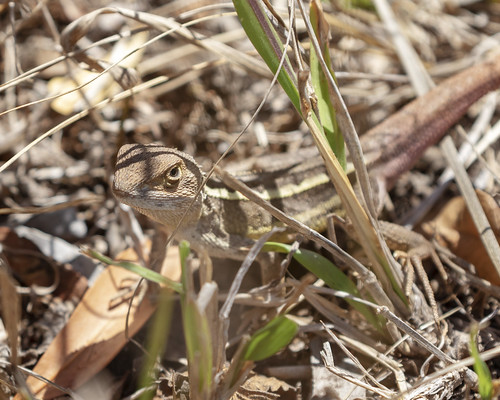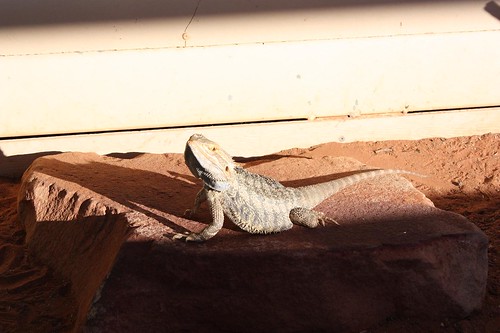Temperatures for bearded dragon tanks at night vary slightly depending on the source, but they usually fall between 70 and 75 degrees Fahrenheit (21 to 24 degrees Celsius).
Without proper temperature regulation, bearded dragons may suffer from various health issues like metabolic bone disease, digestive problems, and respiratory infections.
In this article, we will discuss the importance of maintaining proper temperatures in the bearded dragon tank and provide an overview of the ideal temperature range for these fascinating creatures.
The Importance of Maintaining Proper Temperature
Bearded dragons are cold-blooded reptiles that depend on external heat sources to regulate their body temperature. In their natural habitat, they bask in the sun during the day to absorb heat and retreat into cooler areas at night to avoid overheating.
In captivity, it’s essential to create an environment that mimics their natural habitat as closely as possible. A consistent temperature range ensures that a bearded dragon’s metabolism functions correctly and promotes optimal digestion, immune function, and overall health.
Brief Overview of Ideal Temperature Range for Bearded Dragons
The ideal daytime temperature range for a bearded dragon tank is between 95-110℉ (35-43℃) under the basking spot and cooler temperatures between 75-85°F (24-29°C) on the other side of the enclosure. The nighttime temperature should drop to around 70°F (21°C) but never below 65°F (18°C).
It’s essential to maintain consistent temperatures throughout the day and night cycle by using heat lamps or ceramic heaters controlled by thermostats. Maintaining proper temperatures is critical for your bearded dragon’s well-being.
Overheating can cause lethargy or even death while low temperatures can lead to illness or long-term health problems such as metabolic bone disease.
The Ideal Temperature Range for Bearded Dragons
Bearded dragons are cold-blooded animals, meaning they cannot regulate their own body temperature. As a result, it is crucial to maintain the proper temperature in their tank to ensure their health and well-being.
The optimal temperature range for bearded dragons during the day is between 80-85°F (26-29°C) on the cool side of the tank and 95-105°F (35-41°C) on the basking side.
Explanation of Optimal Temperature Range During the Day
Bearded dragons require a basking spot in their enclosure where they can raise their body temperature to properly metabolize food and digest it efficiently. The basking spot should be maintained at a consistent temperature of around 100°F (38°C) using an appropriate heat source such as a ceramic heat lamp or a halogen light bulb.
The cooler side of the tank should not drop below 80°F (26°C) as this could cause your bearded dragon to become lethargic which may lead to health problems such as respiratory infections.
Discussion of How to Maintain This Temperature Range
Maintaining proper temperatures in your bearded dragon’s tank requires careful attention and monitoring. Heat sources such as basking lamps or ceramic heaters must be used properly, placed in appropriate areas, and correctly controlled with a thermostat or rheostat.
It is also essential to monitor humidity levels in your bearded dragon’s enclosure as this can affect overall temperatures within the habitat.
Importance of Providing a Basking Spot
A basking spot is critical for regulating your bearded dragon’s internal body temperature. Failure to provide this hotspot can lead to digestion problems, metabolic issues, and lethargy. Without proper access to consistently high temperatures, your bearded dragon may become ill and experience a reduced quality of life.
Providing a basking spot and monitoring temperatures using appropriate heat sources is essential to keeping your bearded dragon happy and healthy.
Nighttime Temperatures for Bearded Dragons
Why Nighttime Temperatures are Important?
Bearded dragons, like most reptiles, are ectothermic, which means that they rely on external sources of heat to regulate their body temperature. During the day, bearded dragons require a basking spot with temperatures ranging from 95°F to 105°F.
However, at night they need cooler temperatures to allow their body to rest and recover. Providing proper nighttime temperatures is crucial for your bearded dragon’s health and well-being as it helps maintain their circadian rhythm and digestion.
Ideal Nighttime Temperatures for Bearded Dragons
The ideal nighttime temperature range for a bearded dragon tank is between 65 to 75°F (18°C -24°C). The temperature should not drop below 60°F (15°C) or exceed 80°F (27°C). Some breeders recommend maintaining a temperature closer to the lower end of that range around 65-70°F.
How to Maintain Proper Nighttime Temperatures?
Maintaining proper nighttime temperatures in your bearded dragon tank can be achieved by using proper heating equipment. One option is using a ceramic heat emitter or CHE which emits heat but not light, so it won’t disturb your pet’s sleep cycle.
Some reptile owners use a red heat lamp as an alternative overnight heating source, although this can disrupt pets’ sleep cycles since it emits light in the red spectrum. It’s important to use thermometers and/or thermostats when monitoring nighttime temperatures since too much heat can cause burns or stress to your pet while too little could cause illness or death.
Factors that Affect Nighttime Temperatures in a Bearded Dragon Tank
Discussion on how external factors such as room temperature can affect nighttime temperatures
External factors such as the temperature of the room where the bearded dragon tank is located can have a significant impact on nighttime temperatures. If the room is cold, it can cause the temperature in the tank to drop too low, which can lead to health problems for your bearded dragon.
On the other hand, if the room is too warm, it can cause the temperature in the tank to rise too high and make it uncomfortable for your pet. Therefore, it’s important to choose an appropriate location for your pet’s enclosure that is not exposed to drafts or extreme temperatures.
Importance of monitoring humidity levels and how they affect nighttime temperatures
Humidity levels also play an important role in maintaining proper nighttime temperatures for your bearded dragon. High humidity levels can cause heat retention and raise nighttime temperatures above optimal ranges while low humidity levels can lead to excessive dehydration and lower than desirable night-time temps.
To maintain proper humidity levels, you should regularly mist or spray water in your pet’s enclosure and keep an eye on any changes. Additionally, you should also invest in a quality thermometer/hygrometer combination so that you are able to monitor both temperature AND humidity levels accurately.
Tips on Maintaining Proper Nighttime Temperatures in a Bearded Dragon Tank
Use of Heat Lamps and Ceramic Heaters at Night
Maintaining proper nighttime temperatures in a bearded dragon tank can be achieved with the use of heat lamps and ceramic heaters. Heat lamps are commonly used during the day to provide basking spots for bearded dragons, but they can also be used at night to help maintain consistent temperatures.
Ceramic heaters, on the other hand, emit heat without light and are an excellent choice for nighttime heating as they do not disturb the natural sleep cycle of bearded dragons. Both heating options can be controlled with a thermostat which ensures that the temperature remains constant throughout the night.
Proper Placement and Use of Heating Elements
Proper placement and use of heating elements are crucial to maintaining proper nighttime temperatures in a bearded dragon tank. Heat lamps should not be placed too close to your pet’s enclosure as this can cause overheating or even burns. It is recommended that heat lamps should have a distance of at least 6-8 inches from your pet’s enclosure.
Ceramic heaters, however, do not require such distance restrictions as they emit heat without light. Additionally, it is recommended to provide a hiding spot for your pet during nighttime hours as they may feel more secure in an enclosed area away from any bright lights or movement.
Thermostat Control
Thermostat control is essential when maintaining proper nighttime temperatures for your pet’s health and well-being. A thermostat allows you to regulate temperature accurately while ensuring that it stays within an acceptable range throughout the night. Temperature spikes or drops outside this range may cause stress or harm to your pet.
When selecting a thermostat, ensure you choose one that is designed specifically for reptile enclosures with features such as probe sensors that measure the temperature inside the enclosure. A good thermostat should also have a digital display, and adjustable temperature settings, and be easy to read and use.
Maintaining proper nighttime temperatures in a bearded dragon tank is vital for your pet’s health and well-being. By using heat lamps or ceramic heaters, proper placement and use of heating elements, and thermostat control, you can ensure that your pet remains healthy while getting the needed rest it requires.
Conclusion:
Maintaining proper nighttime temperatures for bearded dragons is crucial to their health and well-being. Providing a safe, comfortable sleeping environment is essential for these creatures to thrive. We have discussed the ideal temperature range for bearded dragons during the day and at night, as well as factors that can affect nighttime temperatures in their tanks.
By monitoring humidity levels and using proper heating elements, such as heat lamps and ceramic heaters, we can ensure that our beloved pets are warm and healthy during their rest periods. It is important to remember that each bearded dragon is unique and may have specific temperature needs based on their age, size, and overall health.
Therefore, it is essential to monitor your pet’s behavior and adjust temperature settings accordingly. With proper care and attention to detail, we can provide a happy home for these fascinating creatures.
As pet owners, it is our responsibility to provide a comfortable living environment for our animals. By adhering to the guidelines outlined in this article while also seeking professional advice when needed, we can ensure that our bearded dragons live long, healthy lives full of warmth and happiness.



